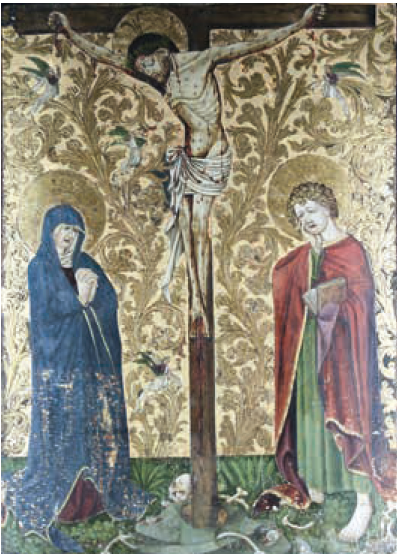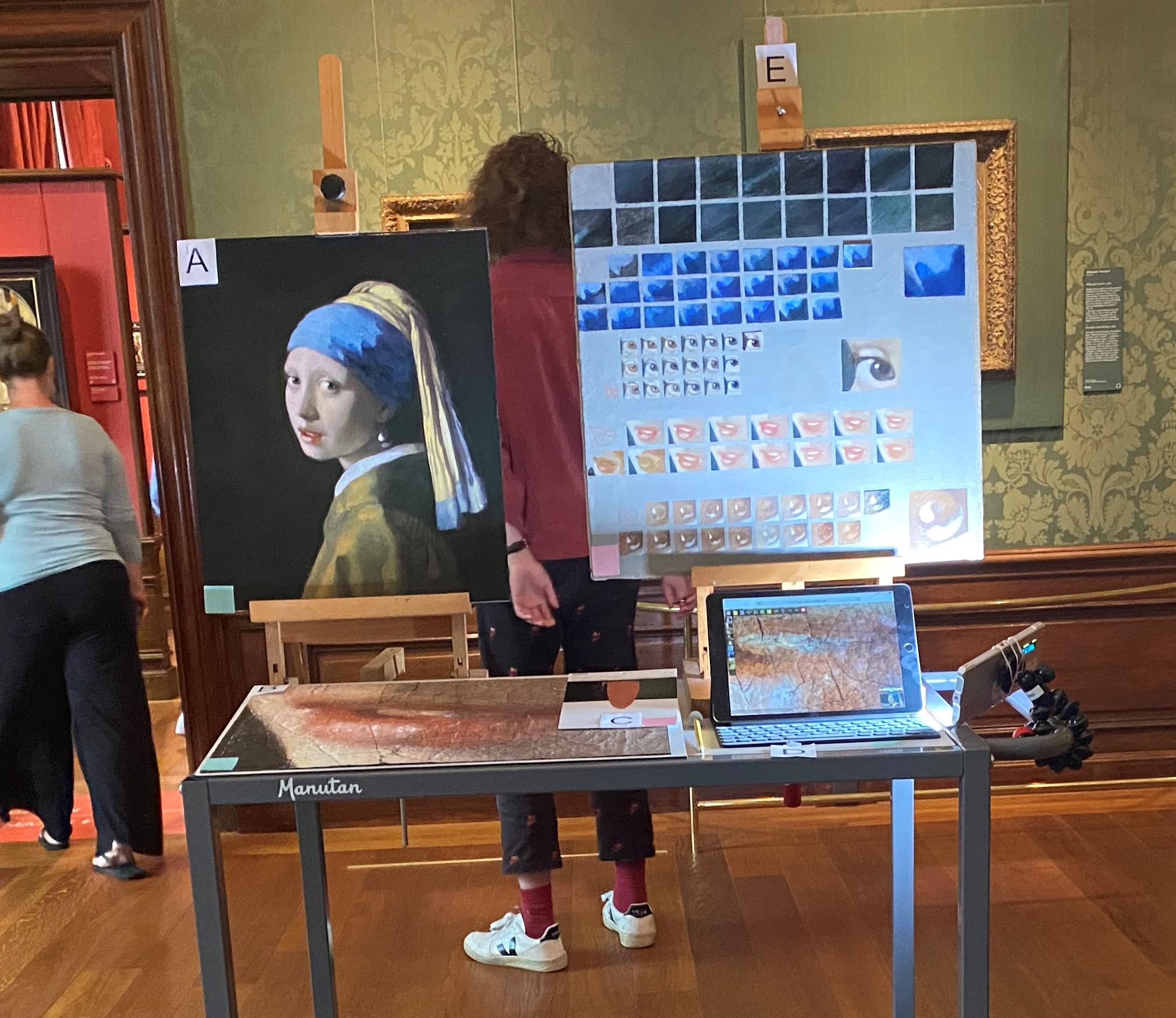Text by Raúl van Dijk Escoriza
The works of art that we see in museums are fragments of what they once were, at least, they are to Liselore Tissen. Current restauration ethics preserve works of art in their current state, including, at times, centuries of discoloration or historical changes. But what if we could see a masterpiece such as Girl with a Pearl Earring as if it just left Vermeer’s studio? The dual PhD candidate (Leiden University and Delft University of Technology) argues that new digital technologies can create new ways to recontextualize, experience and conserve art, besides making the art world a more inclusive and sustainable place. Indeed, the future of the art world is digital. Tissen is member of the LDE Centre for Global Heritage and Development’s new research cluster: Art, Heritage and Science.
Liselore Tissen is interested in the intersection of modern technology and art, specializing in the field of art history and technology. Her PhD research Indistinguishable Likeness seeks to challenge our notions of original and reproduction by investigating the effects of 3D printing technology—which grants the opportunity to create perfect copies—on our appreciation of original artworks. Her cutting edge research has not gone unperceived as Tissen is one of the KNAW’s Faces of Science and is involved in high profile research projects. As such she has worked on Vermeer’s Girl with a Pearl Earring (1665), and is currently helping resolve a restoration conundrum regarding The Crucifixion (ca.1425) by the Master of the Lamentation of the Christ in Lindau.

Part of your research focuses on people’s perception of artworks. To this end you create high quality 3D reproductions altered to show the original colours or emphasize certain characteristics of the artwork. How do people react to these reproductions?
“To be clear, reproductions will never be replacements for original artworks. A very common comment we received while working on our perception study of Girl with a Pearl Earring this year was that the reproductions we made were not the “real deal”. During the Girl in the Spotlight project (2018) the material properties of the painting (i.a. paint, varnish and craquelure) were examined thoroughly. Based on the results of these projects, we now want to see if we could digitally recreate it’s past state and reverse the deterioration caused by time. For the 2021 perception research we had different reproductions of the painting made: a copy made with modern materials (made by Mané van Veldhuizen), a 3D print, a larger than life 3D print and a digital copy. Each was of use for different researchers studying different aspects of the artwork such as material experts trying to understand its physical properties, restorers having a peek at the possible effects of a certain restoration decision, or art historians researching concepts of authenticity. Once you explained this to the audience they quickly understood the added value of such reproductions.”
The boundaries of what we consider conventional or canon are changing faster than we can imagine.

Does taking away the "touch of the master", especially now that almost identical 3D copies can be made, allow us to look at artworks more open-mindedly?
“I do believe so. Indeed, such a reproduction will never have been touched by the artist. However, copies can render a representation of the artwork as originally envisaged by the artist. In that case you can ask if the copies are then truly stripped of the original’s aura?
The study we are conducting on The Crucifixion is exemplary in this case. The 15th century painting is in dire need of restoration. Originally this depiction of the crucifixion of Christ was given a golden texturized background. However, in the 16th century a blue azurite layer was applied over the background, covering both the tremolierung* and certain images below. Opting to restore the painting to one of the earlier versions means taking an irreversible historical decision. This created a perfect opportunity to investigate how people feel towards such conflicts. To this end we created a digital visualization of the painting with its original golden background. This would allow people to experience the painting as if it had just been created, and by candlelight, something the original does not allow. You immediately saw that people started to doubt if the experience of the original could be considered more authentic than the modern visualization, as the second would show the artwork in the same way a Medieval person would have experienced it. This shows how useful this kind of research can be when discussing what makes an artwork authentic, and if age matters in this case. ”

The techniques that you use in your research such as 3D scanning, printing and editing software are becoming ever more available to larger audiences. People with the know-how can then reproduce existing artworks and adapt them to their own liking. Does this mean that the artworld is becoming more democratic, as people are less dependent on the versions of experts?
“Yes, definitely! New digital borne technologies allow people to interact more closely with artworks. A very measurable example would be the immense interest people had for online 3D tours of museums during the covid lockdowns. Furthermore, as ever more museums are digitizing their collections and putting the data online, an increasing amount of people are using it to create their own works of art. The effects of the internet on this tendency should not be underestimated, as it offers a large platform to discuss and form individual concepts of authenticity and personal taste. This translates to all kind of projects, such as AI generated Rembrandt paintings. In this case a machine learning algorithm is fed all the works of Rembrandt after which it creates a painting in his style. Some argue that, conceptually, these paintings could be attributed to him, others disagree. In any case the boundaries of what we consider conventional or canon are changing faster than we can imagine.”
Museums started to shift their focus from exhibition to conservation...which actually means keeping already old and deteriorated paintings that way—ruins of what they once were.
How does this affect the role or authority of museums?
“Museums will have to step up their efforts. Since the last century, with its rise of easily accessible reproductions of artworks (photographs both in print and online), museums started to shift their focus from exhibition to the conservation and material side of artworks. This meant mostly avoiding their further deterioration, which actually means keeping already old and deteriorated paintings that way—ruins of what they once were. What we are seeing now, with the rise of digital media and the results of our perception studies, is that audiences are not just interested in looking at old objects. They are curious to discover new ways to look at artworks, and form new interpretations. Some museums are already experimenting with new forms of exhibitions. For example, the Uffizi gallery in Florence and the Smithsonian have completely digitized their collection and made it freely accessible, this allows for different kinds of museum experience.
This being said, we must not forget that much of the information one can find online on artworks is often either partially true or blatantly incorrect. Museums, being repositories of specialized knowledge, will always fulfil an important role as places for information gathering, research and conservation.”

3D reproductions of Vermeer's Girl with a Pearl Earring (1665) showing different facets of the artwork - Liselore Tissen
What role, if any, can reproductions, 3D printed or otherwise, play in exhibitions?
“There are a multitude of options in this regard. I like to think of it in this way: what gives an original more allure? Hanging in a room full of other originals, or as the only original in a room full of reproductions? I believe the second one can be of more use. On the one hand you can tell the story of the original using the reproductions, highlighting different facets of the original such as brushstrokes, relief or the original colours, things the fragility of the original’s material cannot. On the other, it helps conserve other originals as they can rest in storage instead of being exposed. This could entice private collectors to loan works of art that are otherwise hidden from the general public.
You can also look at reproductions through the lens of sustainable tourism. Many artworks, and even whole heritage sites, are damaged by the vast amount of tourists that visit them. For example, the graves at the Valley of the Kings in Egypt. The frescos on their walls are melting away because of the rise of air humidity tourists cause. For that reason a one-on-one 3D printed reproduction of the grave has been made which can be visited and experienced without damaging the original site. Although it is not very well researched yet, I believe that by explaining to people what the effects of their actions can be they will opt for the more ethical option.”
*Tremolierung is a technique in which small scales are applied to a painting with a gouge.
